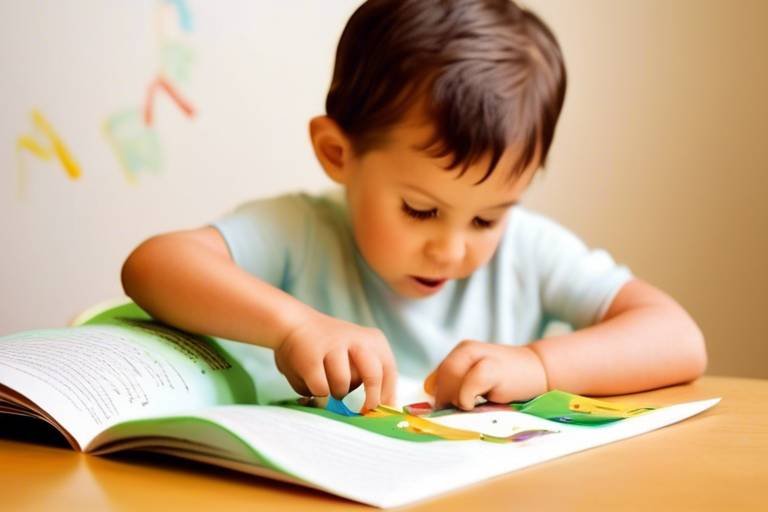Teaching Your Kids About Kindness And Empathy
In a world that often feels chaotic and disconnected, teaching our children the values of kindness and empathy is more crucial than ever. These fundamental traits not only shape their character but also influence the way they interact with others throughout their lives. Imagine a world where every child understands the impact of their actions, where they can step into someone else's shoes and feel their joys and struggles. It’s not just a dream; it’s a reality we can create by nurturing these values from an early age. This article dives deep into why kindness and empathy matter and shares practical strategies that parents can use to instill these essential qualities in their children.
Understanding why kindness is crucial for children's development can motivate parents to teach this value. Kindness is like a ripple in a pond; when one person shows kindness, it has the potential to spread far and wide. It fosters positive relationships, enhances emotional well-being, and contributes to a supportive community. Children who practice kindness are often more accepted by their peers, leading to better friendships and social interactions. Moreover, studies have shown that acts of kindness can even improve mental health, reducing feelings of anxiety and depression. Therefore, instilling kindness isn't just about teaching good manners; it's about equipping children with the tools they need to thrive in society.
Empathy is the ability to understand and share the feelings of others. It allows children to connect with others emotionally, fostering deeper relationships and enhancing their social skills. Teaching kids to recognize and understand feelings is essential for their emotional intelligence. When children can empathize with their peers, they are less likely to engage in bullying and more likely to support one another. For instance, when a child sees another child upset, an empathetic response might be to offer comfort or help. This emotional connection not only strengthens friendships but also builds a more compassionate society.
Helping children identify their own emotions is the first step toward understanding others. When kids can articulate how they feel, they become more aware of the emotions around them. One effective way to promote emotional recognition is through fun activities that encourage kids to express and identify feelings. For example, Emotion Charades is a game where children act out different emotions while others guess what they are. This playful approach not only makes learning fun but also reinforces their ability to recognize and name emotions. Similarly, during Storytime Reflections, reading stories that depict various emotional scenarios can help children discuss and reflect on different feelings, fostering a deeper understanding of empathy.
Imagine a room filled with laughter as children mimic expressions of joy, sadness, or anger. Emotion Charades is not just a game; it's a powerful tool for emotional learning. By acting out emotions, kids learn to recognize these feelings in themselves and others, creating a foundation for empathy.
Reading stories that showcase characters experiencing a range of emotions allows children to see the world through different perspectives. After reading, encourage discussions about how the characters might feel and what they could do to help. This not only enhances their understanding of empathy but also encourages critical thinking.
Incorporating small acts of kindness into daily routines can reinforce the importance of being kind. Simple gestures, such as helping a sibling with homework or sharing toys, can have a lasting impact on children's behavior. When children see kindness modeled in their everyday lives, they are more likely to replicate these actions. Parents can create a Kindness Jar, where every time a child performs an act of kindness, they can add a note to the jar. Over time, this visual representation of kindness can serve as a powerful reminder of the good they can do in the world.
Children learn by observing adults. Therefore, demonstrating empathetic and kind behavior in everyday situations sets a powerful example for kids to emulate. When parents show compassion to others, whether it’s helping a neighbor or listening to a friend in need, children take note. They learn that empathy is not just a value to preach but a way of life. Engaging in community service as a family can also show children the value of kindness in action, making it a tangible experience. Discussing real-life situations where empathy is necessary helps children understand its significance and encourages them to practice it in their own lives.
Engaging in community service or helping neighbors can show children the value of kindness in action. Activities like volunteering at a local shelter or simply helping an elderly neighbor with groceries can make a significant impact on a child's understanding of empathy and kindness.
Talking about real-life situations where empathy is necessary helps children understand its significance. For example, discussing a story in the news that highlights the need for compassion can prompt meaningful conversations about how they can make a difference in their own lives. By encouraging these discussions, parents can help children develop a habit of thinking about others' feelings and perspectives.
- How can I encourage my child to be more empathetic? Start by modeling empathetic behavior yourself and engaging in activities that promote emotional recognition.
- What are some simple acts of kindness my child can do? Encourage them to help a friend, share their toys, or write a thank-you note to someone who has helped them.
- At what age should I start teaching my child about kindness and empathy? It's never too early! Even toddlers can begin to learn about these values through simple interactions.

The Importance of Kindness
This article explores the importance of instilling kindness and empathy in children, offering practical strategies and activities to help parents nurture these essential values from an early age.
Understanding why kindness is crucial for children's development can motivate parents to teach this value. Kindness is not just a nice thing to have; it's a fundamental building block for creating a positive environment around children. Imagine a world where everyone practiced kindness—how much smoother our interactions would be! When children learn to be kind, they are not only enhancing their own lives but also contributing to a more supportive community.
Research shows that children who practice kindness tend to have better relationships with their peers. They are often more accepted and liked, which can lead to improved self-esteem and emotional well-being. Kindness fosters connections, making children feel more secure and valued. This, in turn, promotes a sense of belonging, which is essential for their social development.
Moreover, kindness can act as a ripple effect. When one child performs an act of kindness, it often inspires others to do the same. This shared behavior creates a culture of compassion and support within schools and communities. For instance, a child who helps a classmate with their homework may encourage others to offer assistance in similar situations. It's like planting seeds of positivity that grow and spread, transforming the environment around them.
Incorporating kindness into daily life can be as simple as encouraging children to:
- Share their toys with friends
- Compliment someone on their achievements
- Help a sibling with chores
These small gestures not only teach children the value of kindness but also help them understand its impact on others. When they see the smiles and gratitude of those they help, it reinforces their behavior and motivates them to continue being kind. The more we nurture kindness, the more it becomes a natural part of their character.
Additionally, kindness plays a significant role in emotional resilience. Children who practice kindness are often better equipped to handle adversity. They learn to approach challenges with a positive mindset, knowing they can rely on their kindness to create connections and support networks. This is vital as they navigate the ups and downs of life.
In summary, teaching kids about kindness is not just about instilling a value; it's about shaping their character and worldview. By fostering kindness, we are equipping them with the tools they need to thrive in a complex world. So, let’s embrace the power of kindness and watch our children flourish!
Empathy allows children to connect with others emotionally. Teaching kids to recognize and understand feelings enhances their social skills and emotional intelligence.
Helping children identify their own emotions is the first step toward understanding others. Activities that promote emotional recognition can significantly impact their empathy development.
Playing charades with emotions encourages kids to express and identify feelings, making it both a fun and educational experience.
Reading stories that depict various emotional scenarios can help children discuss and reflect on different feelings, fostering a deeper understanding of empathy.
Incorporating small acts of kindness into daily routines can reinforce the importance of being kind. Simple gestures can have a lasting impact on children’s behavior.
Children learn by observing adults. Demonstrating empathetic and kind behavior in everyday situations sets a powerful example for kids to emulate.
Engaging in community service or helping neighbors can show children the value of kindness in action, making it a tangible experience.
Talking about real-life situations where empathy is necessary helps children understand its significance and encourages them to practice it in their own lives.
Q: How can I teach my child about kindness?
A: Start with small, everyday actions, like sharing and complimenting others. Engage them in community service activities to see kindness in action.
Q: What are some activities to promote empathy?
A: Activities like emotion charades, reading stories with emotional themes, and discussing feelings openly can help children develop empathy.
Q: Why is modeling important in teaching kindness?
A: Children learn by observing adults. By modeling kind behavior, you provide a real-life example for them to follow.

Empathy: The Heart of Connection
Empathy is more than just a buzzword; it’s the glue that holds our relationships together. Think about it: when we truly understand how someone else feels, we create a bridge that connects us on a deeper level. This emotional connection is vital for children as they navigate their social environments. By nurturing empathy, we equip our kids with the tools they need to form meaningful relationships, resolve conflicts, and contribute positively to their communities.
Imagine walking in someone else's shoes; it’s like seeing the world through a different lens. When children learn to recognize and understand the emotions of others, they not only enhance their social skills but also cultivate a sense of compassion. This process begins with helping them identify their own feelings. It’s essential for kids to articulate what they’re experiencing before they can begin to comprehend the emotions of those around them.
To foster this emotional awareness, engaging activities can be incredibly effective. For instance, consider the idea of emotion charades. This fun game encourages kids to express and identify different feelings, making it both entertaining and educational. By acting out emotions, children learn to recognize subtle cues in body language and facial expressions, which are critical for developing empathy.
Another fantastic way to enhance empathy is through storytime reflections. Reading books that depict various emotional scenarios opens up discussions about feelings. After reading a story, parents can ask questions like, “How do you think the character felt when that happened?” This not only helps kids articulate their thoughts but also encourages them to consider perspectives other than their own.
As children practice recognizing emotions in themselves and others, they begin to build a foundation of empathy that will serve them throughout their lives. This foundation is crucial because, in a world that can sometimes feel disconnected, empathy allows us to forge genuine connections with those around us. It’s the heart of connection, the magic ingredient that transforms acquaintances into friends and friends into lifelong companions.
- What is empathy? Empathy is the ability to understand and share the feelings of another person.
- Why is empathy important for children? It helps them build strong relationships, enhances their emotional intelligence, and fosters a sense of community.
- How can I teach my child about empathy? Engage in activities like emotion charades, read stories that explore feelings, and discuss real-life situations that require empathy.
- Can empathy be learned? Yes, empathy can be nurtured through practice and observation, especially by modeling empathetic behavior.

Recognizing Emotions
Helping children identify their own emotions is a crucial first step toward understanding the feelings of others. Imagine emotions as colors on a painter's palette; the more colors a child can recognize, the richer their emotional landscape becomes. When kids learn to articulate what they feel, they not only become more self-aware but also gain the ability to empathize with those around them. This understanding can be nurtured through various engaging activities that promote emotional recognition.
One effective way to facilitate this learning is through games that encourage emotional expression. For instance, Emotion Charades allows children to act out different feelings without using words, which can be both fun and enlightening. As they mimic joy, sadness, anger, or surprise, they begin to associate physical expressions with emotional states. This not only aids in their self-expression but also helps them recognize similar emotions in others. You might be surprised at how quickly kids pick up on these cues!
Another wonderful approach is through Storytime Reflections. Reading stories that showcase characters experiencing various emotions opens up a dialogue about feelings. After reading, parents can ask questions like, “How do you think the character felt when that happened?” or “What would you do in that situation?” Such discussions can illuminate emotional nuances and help children articulate their own feelings, deepening their understanding of empathy. By exploring characters' journeys, kids learn that emotions are complex and multifaceted, much like the world around them.
Incorporating these activities into daily life can significantly impact children’s emotional intelligence. For example, parents can create a simple Emotion Chart at home, featuring different feelings with corresponding facial expressions. This visual aid can serve as a reference point for kids when they find it challenging to express themselves verbally. Here’s a basic outline of what that chart could look like:
| Emotion | Facial Expression |
|---|---|
| Happy | 😊 |
| Sad | 😢 |
| Angry | 😠 |
| Surprised | 😲 |
By engaging in these activities, you are not just teaching your child to recognize their own emotions; you are paving the way for them to develop empathy towards others. This skill is vital as it fosters meaningful connections and nurtures a compassionate mindset. Remember, the goal is to create an environment where emotions can be freely expressed and discussed, allowing children to grow into emotionally intelligent individuals.
- How can I help my child express their feelings? Encourage open conversations about emotions, and model emotional vocabulary in daily interactions.
- What activities can enhance emotional recognition? Activities like Emotion Charades and Storytime Reflections are great ways to help children identify and understand emotions.
- Why is emotional intelligence important for children? Emotional intelligence helps children navigate social situations, build relationships, and develop empathy, which are crucial skills for their overall development.

Emotion Charades
Imagine a game night filled with laughter, excitement, and a sprinkle of learning—this is what brings to your family! This engaging activity not only entertains but also serves as a fantastic tool for teaching children about emotions. The premise is simple: one person acts out an emotion without speaking, while the others guess what it is. This game transforms the often abstract concept of feelings into something tangible and fun.
To kick off your Emotion Charades, gather the family in a cozy space where everyone can see each other clearly. You can create emotion cards that list various feelings like happy, sad, angry, and excited. Each player takes turns drawing a card and acting out the emotion while the others guess. Not only does this foster a playful atmosphere, but it also encourages children to express themselves physically and creatively.
As the game unfolds, you'll notice some interesting dynamics. Children might start to mimic facial expressions or body language associated with different emotions. This is where the magic happens! helps kids learn to recognize and understand feelings not just in themselves, but in others too. It's like holding a mirror to their emotional world, reflecting the importance of empathy and connection.
Moreover, you can spice things up by adding a twist. After guessing the emotion, encourage players to share a time when they felt that way. This could be a simple yet profound way to deepen their understanding of emotions. For instance, if someone acts out feeling frustrated, they might recall a moment when they struggled with homework. This sharing cultivates a rich dialogue about emotions, making it a learning experience that goes beyond the game.
In the end, is not just a game; it's a gateway to emotional literacy. By incorporating such playful yet meaningful activities into your family routine, you're equipping your children with the tools they need to navigate their feelings and the feelings of those around them. So, why not give it a try? You might just find that your family bond strengthens as you laugh and learn together!
- What age group is suitable for Emotion Charades?
Emotion Charades can be enjoyed by children as young as 4 or 5 years old, but it's also engaging for older kids and even adults! - How long should we play?
Typically, a session can last anywhere from 20 minutes to an hour, depending on the interest and engagement of the players. - Can we customize the emotions used in the game?
Absolutely! Feel free to add emotions that resonate more with your family or even create a theme for each game night. - What if my child is shy about acting?
Encourage them gently and consider allowing them to play in pairs or teams initially to build their confidence.

Storytime Reflections
Storytime is not just a delightful way to spend an evening; it’s a powerful tool for teaching empathy and kindness to children. When you read stories that delve into the emotional journeys of characters, you open a window for your kids to explore feelings they might not encounter in their daily lives. Imagine diving into a tale where a character faces challenges, experiences joy, or feels sadness. These narratives can spark meaningful conversations between you and your child, allowing them to express their thoughts and feelings about the situations presented.
One effective way to enhance this experience is by asking open-ended questions during and after the story. For instance, you might ask, “How do you think the character felt when they lost their favorite toy?” or “What would you have done if you were in their shoes?” Such questions encourage children to think critically about emotions and develop their ability to empathize with others. It’s like giving them a roadmap to navigate the complex landscape of human feelings.
Additionally, integrating stories that highlight diverse perspectives can broaden your child’s understanding of the world. By introducing them to characters from various backgrounds, you help them learn that everyone has their own unique experiences and emotions. This not only fosters empathy but also cultivates a sense of global awareness in young minds. A study could show that children exposed to diverse narratives tend to exhibit higher levels of empathy and social awareness.
To make storytime even more engaging, consider creating a cozy reading nook where your child can immerse themselves in the world of stories. You might even incorporate props or costumes related to the story to bring the experience to life. This multi-sensory approach can make the lessons of kindness and empathy stick in ways that mere words cannot.
In summary, storytime reflections are an invaluable opportunity to nurture empathy in your children. By choosing the right stories, asking thought-provoking questions, and creating an engaging environment, you can instill a sense of kindness that will resonate throughout their lives. So, the next time you pick up a book, remember that you’re not just reading; you’re building the emotional foundation for your child’s future.
- How can I choose the right books for teaching empathy? Look for stories that feature characters experiencing a range of emotions and moral dilemmas. Books with diverse characters and situations can provide valuable lessons.
- What if my child doesn't seem interested in reading? Try incorporating storytelling in different formats, like audiobooks or interactive apps, to spark their interest.
- How often should we have storytime? Regular storytime—ideally daily—can reinforce the lessons of empathy and kindness. Even short sessions can be beneficial.
- Can I use movies or shows instead of books? Absolutely! Just ensure to discuss the emotional themes and character motivations afterward to reinforce empathy.

Practicing Kindness Daily
Incorporating kindness into our daily routines isn't just a good idea; it's a fantastic way to cultivate a culture of compassion within our families. Think about it: every small act of kindness is like a pebble dropped into a pond, creating ripples that extend far beyond the initial splash. When we teach our children to practice kindness daily, we’re not just filling their hearts with warmth; we’re also equipping them with the tools to navigate life’s challenges with grace and empathy.
So, how can we make kindness a regular part of our lives? It all starts with intentionality. Here are a few practical strategies that can help:
- Daily Kindness Challenges: Set aside a few minutes each day for your kids to think of one kind act they can do. It could be as simple as complimenting a friend or helping a sibling with homework. By making it a challenge, you introduce an element of fun and excitement!
- Kindness Jar: Create a kindness jar where family members can drop in notes about kind acts they've witnessed or performed. At the end of the week, read them together. This not only reinforces positive behavior but also sparks conversations about kindness.
- Gratitude Practice: Encourage your children to express gratitude for the kindness they receive. A simple "thank you" can go a long way in recognizing the efforts of others and fostering a sense of appreciation.
These activities not only teach children the importance of being kind but also help them develop a sense of responsibility towards others. Imagine the joy on their faces when they realize that their small gestures can bring smiles to others! Kindness becomes a habit, and before you know it, it’s woven into the fabric of their daily lives.
Moreover, don't underestimate the power of role modeling. Kids are like sponges, soaking up everything they see. When they observe you practicing kindness—whether it’s holding the door for someone, helping a neighbor, or simply being polite—they learn that kindness is not just a value, but a way of life. You might even find that they start to imitate your behavior in delightful ways, turning your home into a hub of kindness!
Remember, kindness is not always about grand gestures. Sometimes, it’s the little things—a warm smile, a helping hand, or a few kind words—that leave the most significant impact. By embedding kindness into your family’s daily routine, you’re not just teaching your kids to be nice; you’re nurturing a generation that understands the profound effects of empathy and connection.
Q: How can I encourage my child to be kind if they are naturally shy?
A: Encourage small acts of kindness that don’t require extensive social interaction, like writing a kind note to a friend or family member. Gradually, as they become comfortable, they can take on larger gestures.
Q: What if my child is being unkind to others?
A: Address the behavior immediately. Discuss the consequences of unkind actions and help them understand how it affects others. Encourage them to apologize and make amends.
Q: How can I measure the impact of kindness in my child’s life?
A: Look for changes in their interactions with peers, increased empathy in their responses, and their willingness to help others. You can also ask them about their feelings regarding kindness and empathy regularly.

Modeling Empathy and Kindness
When it comes to teaching our kids about empathy and kindness, one of the most powerful tools we have at our disposal is our own behavior. Kids are like little sponges, soaking up everything they observe in their surroundings. This means that if we want them to embody these values, we need to lead by example. Imagine a garden: if we want it to flourish, we must tend to it with care and attention. Similarly, our actions can sow the seeds of kindness and empathy in our children's hearts.
Think about it: when children see their parents engaging in kind acts, whether it's helping a neighbor carry groceries or volunteering at a local shelter, they start to understand that kindness is not just a word but a way of life. It's like showing them the ropes in a game—they learn the rules by watching how we play. To truly make an impact, we can incorporate simple, everyday acts of kindness into our routines. This could be as straightforward as saying "thank you" to a cashier or holding the door open for someone. These seemingly small gestures can leave a lasting impression on young minds.
Moreover, discussing these acts of kindness openly with our children can amplify their understanding. When we share stories about our experiences, we create a narrative that reinforces the importance of empathy. For instance, after helping someone in need, we might ask our kids how they think that person felt. This not only encourages them to think critically but also helps them connect their actions with the feelings of others. It's like connecting the dots in a picture; the more dots they connect, the clearer the image becomes.
Another effective approach is to engage in community service as a family. Participating in activities that benefit others not only teaches children about the value of kindness but also allows them to see the direct impact of their actions. Whether it's organizing a food drive or cleaning up a local park, these experiences can be transformative. They provide a tangible sense of accomplishment and a deeper understanding of the world around them.
To illustrate the importance of modeling empathy and kindness, consider the following table that outlines various everyday situations where parents can demonstrate these values:
| Situation | Action | Lesson for Kids |
|---|---|---|
| Helping a neighbor | Offer assistance with yard work | Teamwork and community support |
| Volunteering | Participate in a local charity event | Importance of giving back |
| Discussing feelings | Talk about emotions after a movie | Understanding and recognizing emotions |
In conclusion, modeling empathy and kindness isn't just about teaching our kids to be nice; it's about ingraining these values into their very being. By actively demonstrating these traits in our daily lives, we create a nurturing environment where our children can thrive emotionally and socially. They learn that kindness is not just a choice but a fundamental part of being human. So, let’s roll up our sleeves and show our kids how to cultivate a garden of empathy and kindness, one small act at a time.
- How can I start teaching my child about kindness? Begin with small, everyday acts of kindness and openly discuss the feelings associated with those actions.
- What age is appropriate to start teaching empathy? Children can start learning about empathy as early as preschool age. Simple discussions about feelings can be very effective.
- How can I encourage my child to practice empathy with their peers? Encourage them to listen actively and discuss their friends' feelings during playdates or school activities.

Everyday Acts of Kindness
Engaging in is a powerful way to not only teach our children the value of compassion but also to create a ripple effect of positivity in our communities. Imagine a world where every small gesture of kindness adds up, transforming our neighborhoods into supportive havens. It's like planting seeds; each act nurtures the soil of empathy and kindness, allowing it to flourish over time.
So, what does this look like in practice? It can be as simple as holding the door open for someone, offering a smile to a stranger, or sharing a toy with a sibling. These seemingly small actions can have a profound impact. When children witness their parents engaging in kind behavior, they learn that kindness is not just an isolated act; it's a way of life. For instance, when you help a neighbor carry groceries or check in on an elderly friend, your kids see firsthand the joy that comes from helping others. This can inspire them to look for opportunities to be kind themselves.
To make kindness a regular part of your family’s routine, consider setting aside a specific day each week dedicated to performing acts of kindness. This could include:
- Writing thank-you notes to teachers or community helpers.
- Donating toys or clothes to those in need.
- Volunteering at a local shelter or food bank.
By incorporating these activities into your weekly schedule, you create a tradition that emphasizes the importance of kindness. It becomes a shared family value, reinforcing the idea that every little bit counts.
Moreover, discussing the impact of these acts can deepen your child's understanding of kindness. After an act of kindness, sit down together and reflect on how it made both of you feel. Ask questions like, "How do you think that person felt when we helped them?" or "What was your favorite part of our kind act today?" Such conversations can help children connect their actions with the emotions of others, strengthening their empathetic skills.
In the end, the goal is to make kindness a natural part of your children's lives. By modeling these behaviors and encouraging them to participate in acts of kindness, you are not only helping them develop into compassionate individuals but also fostering a sense of community and connection that benefits everyone.
Q: How can I encourage my child to be more kind?
A: Start by modeling kind behavior yourself. Children often imitate what they see. Engage in discussions about kindness, and create opportunities for them to practice it in their daily lives.
Q: What are some simple acts of kindness we can do as a family?
A: Some simple acts include baking treats for a neighbor, writing thank-you notes, or volunteering together at a local charity. The key is to make it fun and engaging!
Q: How do I talk to my child about empathy?
A: Use stories and real-life examples to illustrate empathy. Encourage them to express their feelings and to consider how others might feel in different situations.

Discussing Empathy in Real Life
Discussing empathy in real life is not just about having a conversation; it's about creating a safe space where children feel comfortable expressing their thoughts and feelings. This practice can help them understand the importance of empathy in everyday interactions. Start by sharing real-life scenarios, perhaps from your own experiences or from news stories, to illustrate how empathy plays a role in various situations. For instance, you might say, “Remember when we saw that person struggling with their groceries? How do you think they felt?” This simple question can open the door for a deeper discussion about feelings and reactions.
Using relatable examples is key. Children often relate better to situations they can visualize. You might consider discussing scenarios like:
- A friend feeling sad because they lost a game.
- A classmate being bullied and how it affects them.
- A family member going through a tough time and needing support.
By discussing these instances, you can encourage your child to put themselves in someone else's shoes. Ask them how they would feel in those situations and what they could do to help. This not only enhances their emotional intelligence but also strengthens their ability to empathize with others.
Moreover, role-playing can be a fun and effective way to practice empathy. Create scenarios where your child has to respond to someone in need. For example, you could pretend to be a friend who is upset, and your child can practice comforting you. This hands-on approach makes the concept of empathy more tangible and allows children to experiment with different responses. They learn that sometimes, just listening is the best way to show empathy.
It’s also beneficial to incorporate discussions about empathy into daily routines. For instance, during family meals, you could ask everyone to share a moment from their day where they felt empathy or witnessed someone showing it. This not only reinforces the concept but also builds a family culture of kindness and understanding.
Finally, don't underestimate the power of media. Books, movies, and even cartoons often present situations that can spark discussions about empathy. After watching a show together, ask your child questions like, “How do you think the character felt when that happened?” or “What would you have done in their place?” These questions can lead to insightful conversations that help solidify their understanding of empathy in a fun way.
Q: How can I tell if my child is developing empathy?
A: Look for signs such as their ability to recognize and respond to others' feelings, their willingness to help others, and their sensitivity to the emotions of those around them.
Q: What if my child struggles with empathy?
A: It's normal for children to have varying levels of empathy. Continue to engage them in discussions about emotions and provide opportunities for them to practice empathetic behavior.
Q: Are there specific activities that can help teach empathy?
A: Yes! Activities like volunteering, reading books with emotional themes, and role-playing can significantly enhance a child's understanding and practice of empathy.
Q: How important is it to model empathy as a parent?
A: Extremely important! Children learn a lot by observing their parents. Demonstrating empathetic behavior in your daily life sets a powerful example for them to follow.
Frequently Asked Questions
- Why is it important to teach kindness and empathy to children?
Teaching kindness and empathy to children is crucial because it helps them build positive relationships, enhances their emotional intelligence, and fosters a supportive community. When kids learn to be kind, they not only improve their social skills but also contribute to a more compassionate world.
- What are some effective activities to promote empathy in kids?
There are several fun and engaging activities to help kids develop empathy. For instance, playing Emotion Charades encourages children to express and identify feelings. Additionally, Storytime Reflections can be a great way to discuss different emotional scenarios, allowing kids to reflect on and understand various feelings.
- How can parents model kindness and empathy?
Parents can model kindness and empathy by demonstrating these behaviors in everyday situations. Simple acts, such as helping a neighbor or volunteering in the community, show children the value of being kind. When kids see their parents practicing empathy, they are more likely to imitate those actions in their own lives.
- Can small acts of kindness really make a difference?
Absolutely! Small acts of kindness can have a significant impact on children's behavior. Incorporating simple gestures into daily routines reinforces the importance of kindness, making it a natural part of their lives. Even something as simple as sharing a toy or complimenting a friend can create a ripple effect of positivity.
- How can discussing real-life situations help children understand empathy?
Discussing real-life situations where empathy is needed helps children grasp its significance. By talking about scenarios they encounter, kids learn to recognize when empathy is necessary and how to respond appropriately. This practice encourages them to apply empathetic thinking in their own interactions.



















